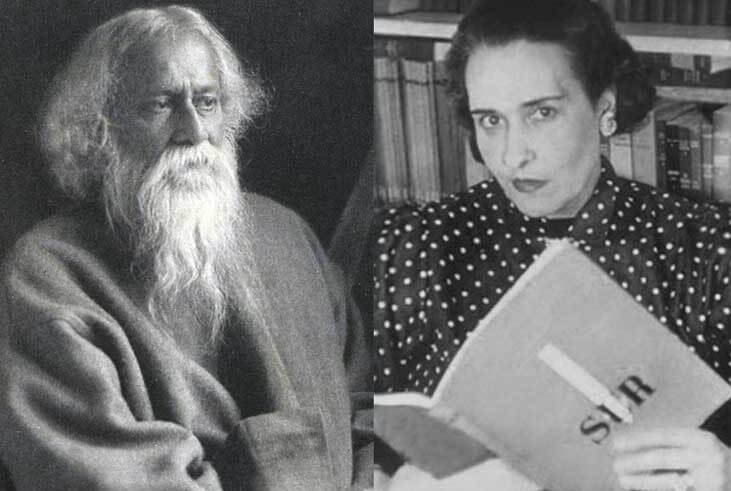
Today is Pochishe Boisakh, the day Rabindranath Tagore was born, and the day we remember him not just as a great poet, but as a silent force that still lingers in the folds of our everyday life. The 25th day of the Bengali month of Boisakh… every year, this day rolls in like an old friend, reminding us of his songs, his spirit, and how deeply he still lives in the corners of our lives. Rabi Thakur, as we call him with love, isn’t just remembered… he’s felt. In the breeze that rustles through Krishnachura blooms, in the strains of Rabindrasangeet that float softly through the morning air, in the quiet corners of our hearts where his words continue to live… the poet is felt.
Yet, while admiring him, we often overlook the quiet influences that shaped him… the women in Tagore’s life. They weren’t just fleeting inspirations; not footnotes in his story. They were soul companions, intricate personalities who deeply impacted his inner world. Tagore, is a name that whispers through generations. His words… a comfort, a refuge in good times and bad. But who walked beside this great poet? Whose emotions mingled with his to create those timeless verses?
Kadambari Devi: The Lost Queen of His Heart

I first read about Kadambari Devi during my student years. Her story haunted me like anything…for days. In 1884, young Tagore wrote in a letter to friend C.F. Andrews, of his devastating loss: “She, my Queen, has died and my world has shut against the door of its inner apartment of beauty…” The ‘Queen’ he mourned was Kadambari Devi, his sister-in-law, his childhood confidante, with whom he shared a soul-knit bond.
Married into the Tagore family at just ten, she was young poet’s playmate. She was his sharpest critic, a partner in his imaginative world. After his mother passed away, it was Kadambari who quietly stepped in, she tried by all means to soften his grief with warmth.
Their bond matured, as they grew, expressed in letters, poetry, and a connection so deep, words often fell short.
When Tagore briefly went abroad, he wrote to Kadambari. But their unique relationship, often misunderstood, was forever changed, when he was suddenly married to young Bhavatarini Devi. Just four months later, Kadambari took her own life.
The silence that followed echoed in Tagore’s poems. His words for her didn’t fade; they grew richer, becoming a part of his enduring literature.
Their bond was intimate, layered, and truly felt. Tagore would later pour his memories into verses that are soaked in longing. The song ‘Tumi ki keboli chhobi?’… is believed to be for her. Perhaps the poet asks: ‘Are you now just a mere portrait?’… Every time I listen to the song, I am struck by its ache… as though the poet is still searching for her in the silence. I feel that ache too.
It’s hard to read that and not think of Kadambari… not as a muse, but as someone whose absence lingered like perfume in an empty room. A young girl ended her life… too soon, too silently. She wasn’t just a passing spark; she glowed… quietly, constantly, somewhere in the background of his heart.
Nalini: A Gentle Flame in a Distant Land

What about Anna or Nalini? Before his time in England, Tagore spent time in Mumbai, where he met Annapurna or Anna, a Marathi girl. The daughter of a progressive doctor, Anna belonged to an anglicized household where Tagore stayed briefly. She became his English tutor, but more than that, she transformed into ‘Nalini’ in his mind.
In just few months, a quiet warmth blossomed between them. It wasn’t a youthful infatuation but a subtle meeting of minds. Tagore was drawn to her elegance, her composure, and her easy movement between cultures, so different from the women he knew. He would later immortalize her as Nalini in his poetry, evoking her presence in verses that carried both intimacy and longing. In one such song, Shuno Nalini kholo go ankhi, he gently urges her to awaken as the poet, “her Robi,” has arrived:
Oh! Nalini, open your eyes
Is sleep still to abandon its ply?
See, standing at your door
The rising sun’s first score
Hearing my morning song
See all around the shroud of sleep has gone.
He kept calling her Nalini over the years, a quiet echo of what once was.Their paths diverged gently. Anna married, moved to Edinburgh, and passed away young. She always signed her name ‘Nalini.’ And Tagore never forgot her, keeping her alive in poems, stories, and letters… a distant, gentle light. Yet… she remained. Was it love? Was it loss? Or both?
Mrinalini: The Steady Anchor

Mrinalini, born Bhavatarini Devi, entered Tagore’s life unexpectedly. She was just eleven and he twenty-two. Their early relationship was shaped by tradition and expectation. But over time, she became more than just a wife.
Determined to be his partner, not just someone behind him, Mrinalini embraced learning literature, languages, culture. Quietly, she evolved into a steadfast companion who understood the man still marked by Kadambari’s memory. As time passed, Tagore’s affection for her deepened. In his letters, scattered across his travels, there’s tenderness… a kind of quiet thoughtfulness, and a comforting sense of home.
Tragedy struck again when Mrinalini passed away at twenty-nine, leaving Tagore heartbroken. He poured his grief into Smaran, a collection of 27 poems, each verse attempting to hold onto the warmth that was lost. As I sit with those poems, I am at a loss for words.
Victoria Ocampo: A Late Bloom of Affection

Years later, in the quiet isolation of Argentina, ailing and far from home, Tagore found solace in the villa of Victoria Ocampo, a writer and intellectual in her own right. Tagore named her Vijaya. Their bond was not born out of longing, but grew in the quiet friendship of mutual respect and intellectual kinship. Ocampo, ever the gracious host, cared for Tagore during his declining health. She offered him not just comfort but a deep connection in the twilight of his life. She described their relationship as one of ‘love tenderness’, an affection that transcended the usual labels of love or friendship, touching a space that was intense and spiritual.
In the presence of Ocampo, Tagore’s poetry found a new, intimate expression. He wrote poems for her, about her, and sometimes even when she was around… capturing that quiet comfort, that deep, wordless understanding between them. In one of his letters, Tagore penned: “This love between you and me is as simple as a song,” a testament to the purity and ease of their connection.
Tagore’s words for her were not driven by desire or loss, but by a gratitude for the quiet, steady affection she offered. In her, he found not just a caretaker but a partner in thought. Ocampo, in turn, reminded the world that even the greatest minds experience loneliness, and that all of us, no matter how esteemed, need comfort.Their bond, perhaps marked by their own journeys, found solace in each other’s presence.
Beyond Muses: The Heartbeat of His Poetry

Each woman who crossed Tagore’s path left an imprint… something unique. Perhaps a spark, a shadow, a melody. They weren’t just figures to admire or muses to inspire. They were intelligent, original and courageous women who shared their minds and souls with a poet who, in turn, captured their essence in songs and verses that would outlast time.
Tagore’s genius didn’t grow alone; it was shaped by those around him, nurtured by Kadambari’s deep companionship, Nalini’s early tenderness, Mrinalini’s devotion, and Victoria’s thoughtful care. Their role wasn’t just for show; it was integral – much essential to his journey, woven into the very fabric of his creativity.
When we remember Tagore, we must also remember them. Not as women standing in the shadow of a great man, but as voices woven into his poetry, heartbeats in his songs, and reflections of a genius who felt deeply… and never let them go.
And in remembering them, we too become part of his world… not as mere admirers from afar, but as souls drawn to the depth of his words. Kadambari, Nalini, Mrinalini, Vijaya… live in the silences between his lines, in the pain, in the wonder, in the search. When we feel something stir in our hearts while reading him… maybe it’s them we are hearing too.


Lovely piece. Now i want to, will hopefully, read more about Gurudev.